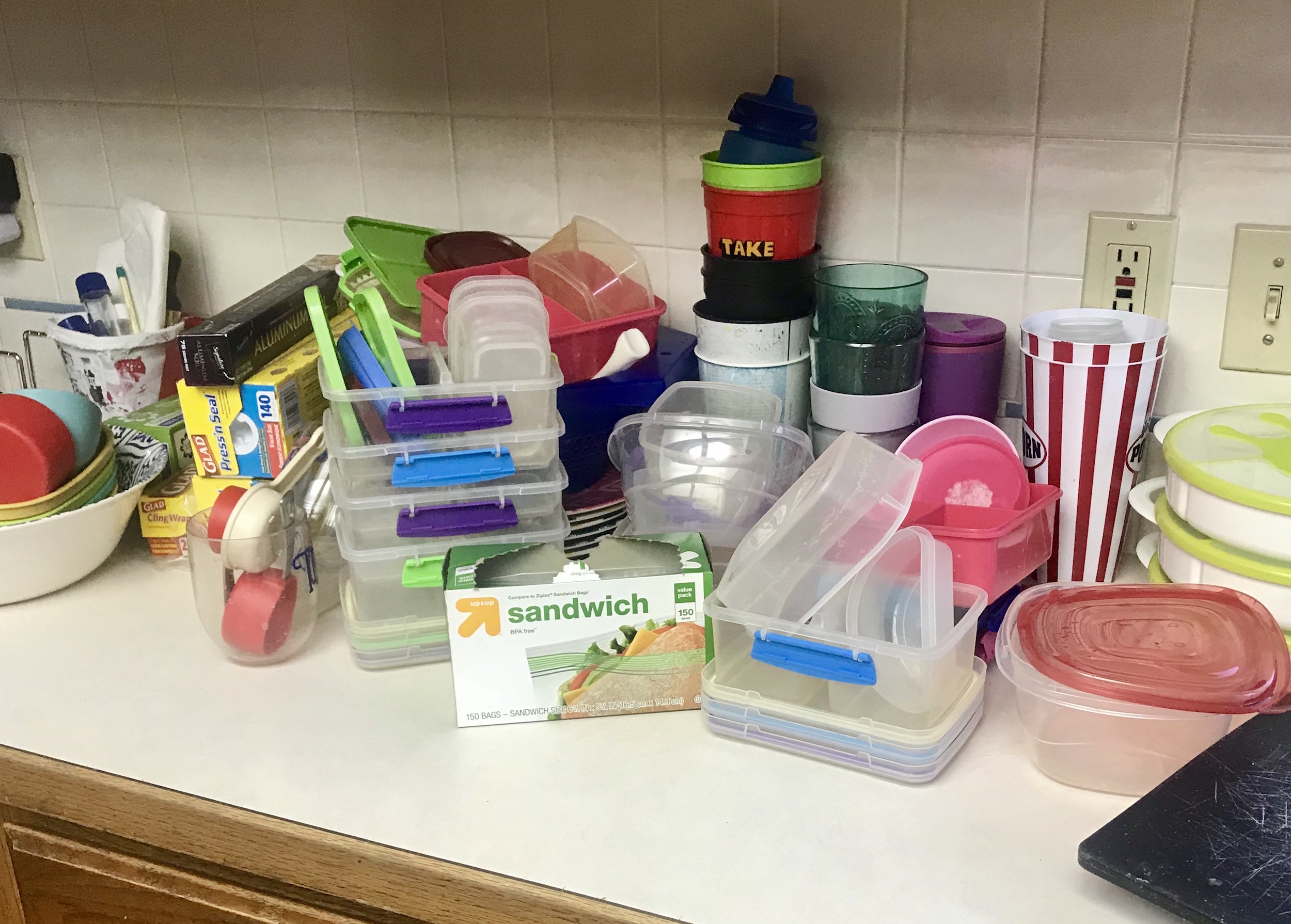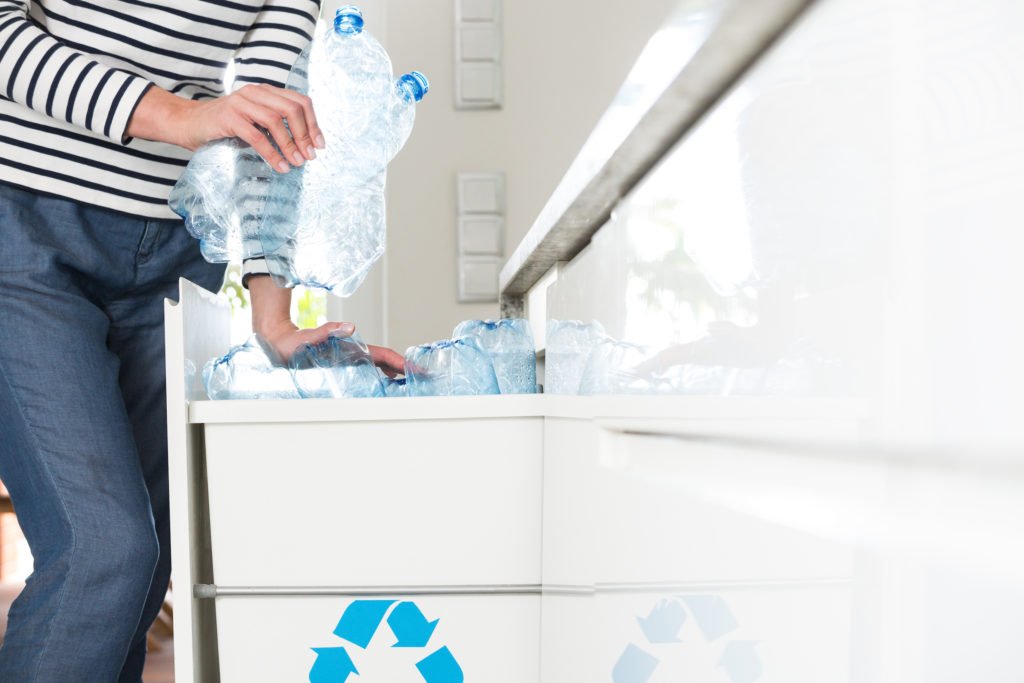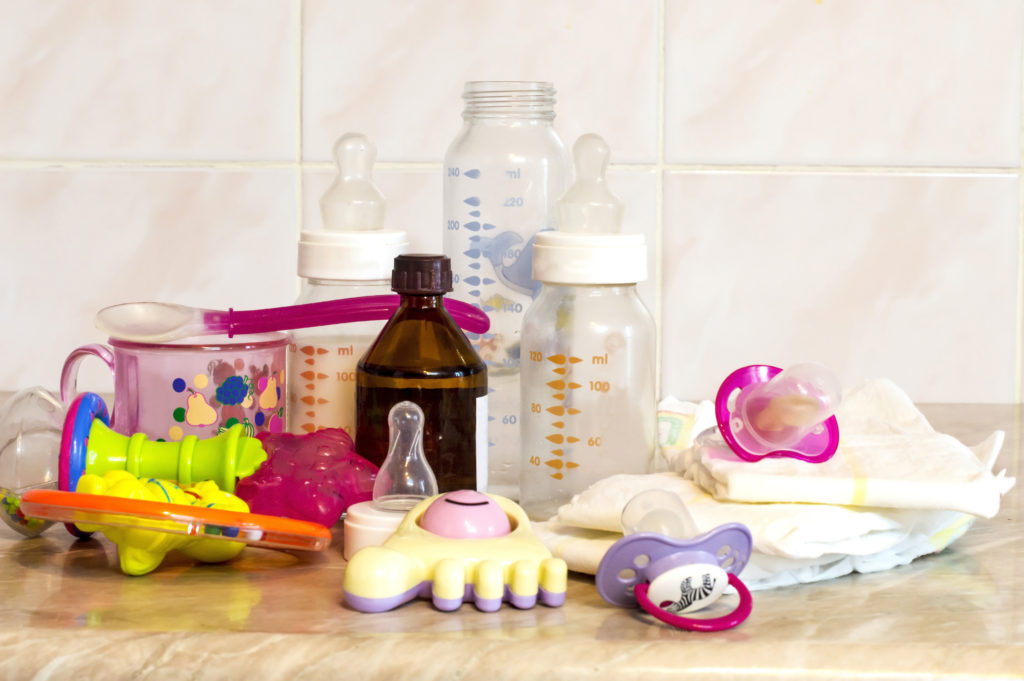
Inside This Post: Baby steps to help remove chemical exposure by reducing plastics in your home. Safe alternatives instead of plastic & reduce toxin exposure at home.
This post may contain affiliate links. You can see my disclosure policy here.
Reduce Plastics & Chemical Exposure in Your Home
Look around right now.
I bet you see plastic materials all around you.
Cups, containers, storage bins, toys, food storage, lunchbox, chairs, etc.
Today, plastic has become the main material for so many things we have in our homes, that our children play with and we use each day to care for our babies. It’s also the main packaging material used in a large percentage of food storage.
Here is a classification system developed to help you identify the common types of plastic in your home and what is approved for recycling.
- #1 – Polyethylene Terephthalate (PET or PETE) absorbs odors and flavors from foods and drinks stored in them. Items made from this plastic are commonly recycled. PET(E) plastic is used to common household items like beverage bottles, pre-prepared food trays, roasting bags, condiments, tough fibre clothing and carpets, microwave transparency film, shampoo bottles and mouthwash bottles.
- #2 – High-Density Polyethylene (HDPE) are commonly recyclable. Made in products like milk jugs, water jugs, shampoo, detergent and bleaches, snack food boxes and cereal liners, grocery bags, toys, buckets and plant pots. It is NEVER safe to reuse an HDPE bottle as a food or drink container if it didn’t originally contain food or drink (like motor oil.)
- #3 – Polyvinyl Chloride (V or PVC) is used for all kinds of pipes and tiles, but is most commonly found in plumbing pipes. Also used in shower curtains, plastic toys, table cloth mats, medication blister packs, wrapping films, credit cards and synthetic leather products. This kind of plastic should not come in contact with food items as it can be harmful if ingested.
- #4 – Low Density Polyethylene (LDPE) and products include cling-wrap, sandwich bags, hot/cold beverage cups, paper milk cartons, squeezable bottles, bubble wrap, bottle tops and plastic grocery bags are made from LDPE.
- #5 – Polypropylene (PP) is strong and can usually withstand higher temperatures. It is used to make lunch boxes, margarine containers, take-out containers, yogurt pots, syrup bottles, ketchup bottles, waxy surface potato crisp bags, biscuit wrappers, drinking straws, prescription bottles. Plastic bottle caps are often made from PP.
- #6 – polystyrene (PS or Styrofoam) are items such as disposable coffee cups, take-out food boxes, plastic cutlery, packing foam, and meat trays.
- #7 – Code 7 is used to designate miscellaneous types of plastic not defined by the other six codes. Polycarbonate and Polylactide are included in this category. These types of plastics are difficult to recycle like utensils, and food storage containers. Polycarbonate (PC) is used in baby bottles, compact discs, and medical storage containers.
Here’s a full PDF of the codes for reference.

Health Concerns Surrounding Plastic in Your Home
Over the 50 years plastic has been used and becomes more prevalent in households across the word, there has been mounting evidence about the safety of chemicals used to produce plastic and the threat they pose in your home.
Some of the biggest concerns about the use of plastic are the use of chemicals, BPA and alternates to BPA and Phthalates.
Here’s why they’re dangerous when they’re in your plastics in your home:
BPA and Replacements to BPA (BPS and BPF)
BPA (Bispehnol A) is a documental chemical called an endocrine disruptor (creates hormone imbalance which negatively alters reproductive, immune and neurological health.)
The Centers for Disease Control and Prevention found BPA in the urine of 93 percent of the people it tested.
Low-dose exposure to BPA may produce a variety of physiological problems, including:
- obesity;
- infertility;
- aggressive behavior;
- early onset of puberty;
- hormone-dependent cancers such as prostate and breast cancer; and
- lower testosterone levels and sperm production.
BPA exposure occurs when the chemical leaches out from the product into food and water, especially when plastic containers are washed, heated or stressed.
For example, if you microwave your plate of leftovers that’s made with BPA, the heat causes the chemicals to leach into your food, exposing you or your kids to BPA which is then ingested and administered to your organs and enters your bloodstream.
The highest estimated daily intakes of BPA occur in infants and children directly from contact with every day contact to plates, bottles, cups, utensils, toys and pacifiers.
BPA is finally being removed from many plastic items, but the alternative chemicals used to replace it are no better. Bisphenol S and F (known as BPS and BPF) have similar structures and potencies to BPA. Some even had more dangerous activity than products containing BPA itself.
Your best option to remove BPA and alternative exposure is to reach for stainless steel and glass alternatives. (I’ll talk safe alternatives you should use below.)
Phthalates
Phthalates are chemicals used to soften plastics and help scents and chemicals bind together.
They are found in a wide variety of products, including shampoos, conditioners, body sprays, hair sprays, perfumes, colognes, soap, nail polish, shower curtains, medical tubing, IV bags, vinyl flooring and wall coverings, food packaging and coatings on time-release pharmaceuticals.
The National Institute of Environmental Health Sciences (NIEHS), part of the National Institute of Health, has found that pre-natal exposure to phthalates is associated with adverse genital development and can significantly reduce masculine behavior in boys.
Exposure to phthalates has been associated with lower IQ levels.
Phthalate exposure is widespread in the United States, according to research done in 2009 in the Fourth National Report on Human Exposure to Environmental Chemicals. Women had much higher rates of exposure. That’s because they used more products with phthalates — products like soaps, shampoos, cosmetics and body washes.
Phthalates then can wind up in your body after you eat or drink food that has been in any contact with the plasticizer. You can also breathe it in from vapors or dust that contain phthalate particles.
Fortunately, as with BPA, if exposure is decreased, phthalates quickly exit the body.
One specific compound, known as Di(2-ethylhexyl) phthalate or DEHP, is listed as “reasonably anticipated to be a human carcinogen” in the Thirteenth Report on Carcinogens published by the National Toxicology Program. Manufacturers began to remove DEHP from consumer plastics 10 years ago, but new studies suggest that the two stand-in chemicals, DINP and DIDP, are just as harmful.

How to Reduce Plastic Use In Your Home
The thought of removing every piece of plastic in your home is overwhelming. I get it, because I too was overwhelmed when I looked around and say plastic everywhere.
It’s not realistic to say that you should get rid of plastic items immediately at all at once. You can begin the transition to moving towards greener materials over time.
Simple steps can help you reduce your plastic use and improve the health of your family one well-planned baby step at at a time.
Choose Reusable & Safe Alternatives
The biggest source of plastics in your home is likely found in your kitchen.
This is the first place I recommend making changes to stainless steel water bottles, glass and stainless steel for cooking, baking, drinking and food storage. These alternatives don’t leach harmful chemicals like plastics, non-stick and melamine do.
Reusable stainless steel products like plates, bowls, and storage containers (also perfect for lunch boxes) are non-reactive and also not expensive.
Storing ingredients in mason jars and glass containers keeps disposable and toxic-lined bags out of your home. BPA-free, safe and non-toxic storage bags are also good for packing lunches, saving left overs and replacing plastic bags in your fridge and pantry.
Over the last year, our family has completely transitioned away from using plastic by making one switch after another, and using these plastic-free items:
- Stainless steel water bottles – my kids each have two stainless steel water bottles; one that goes to school with them everyday (they bring it home because we refill it with filtered water through our aquagear water pitcher and don’t drink the tap water at school), and one to keep at home to drink from, bring to activities, or by their bed at night. We have these Kleen Kanteen with the sports lid and the Hydro Flask with the sports top since unscrewing the lid and putting it back on tightly enough can be hard for little ones. Both sports tops are BPA free. My husband and I have these large 32oz Simple Modern water bottles and love, love, love them.
- Stainless steel coffee mugs – We’re on the go a lot and when we aren’t using our coffee mugs at home, these are our go-to stainless steel coffee tumblers.
- Stainless steel straws – plastic straws are not only filled with chemicals, but they’re super bad for the earth. Making the switch to stainless steel straws if you don’t like drinking straight from the cup is a really easy switch to make.
- Stainless steel cups – These are the perfect sizes for my kids and virtually unbreakable. The silicone and completely toxic-free cup holders are a nice bonus for little hands and to keep them from slipping and dropping a full glass. The colors are helpful if you have more than one child to keep from getting cups mixed up. I keep the kid’s stainless steel water bottles and these cups on a low shelf so they can help themselves to water whenever they need it.
- Stainless steel strainers – When plastic materials are heated, especially when you’re pouring hot food that needs to have the liquid removed through a plastic strainer, that’s when the chemicals are leached into the food. I only use stainless steel strainers when I’m draining pastas or steamed vegetables to avoid any toxins contaminating in our food.
- Pyrex glass food storage containers with BPA free lids – Storing food should always be in glass containers or stainless steel, and never in plastic bags,zip top plastic bags or cans. You don’t want to put hot food in any of these containers, but you also don’t want to reheat them in there either. Storing food in these pyrex glass containers (with BPA free lids) keeps food free from exposure during the saving and reheating process. We have this set because the variety of sizes is good to have on hand and I even use the smaller pieces for lunch boxes, too.
- Glass mason jars – The quart and 16oz mason jars can be used for so many things in your kitchen! From storing ingredients, drinking out of, storing soups, sauces, broths and even leftovers. We use mini mason jars for spices and other DIY items we create and the really large, 1 gallon containers for storing noodles, flour, rice, making kombucha and fermented foods.
- Silicon food storage – I recently discovered these collapsable silicon food bags to replace our ziplock bags and they are working great so far. The silicon is pretty thick but they’re BPA and BPS free and clean up easily to reuse again and again.
- Non-toxic and sealable lunch bags – I send the kids to school with a lot of items that need their own bags like sandwiches, dried fruit and snacks. These lunch skin bags are non-toxic, seal with an easy strip at the top and I can even write a little love note to my kids. The patterns are cute, too!
- Ditch Aluminum Foil and use parchment paper instead. Aluminum foil is not food grade like aluminum metal is, so when it’s heated to high temps, the aluminum leaches straight into your food.
- Glass baking dishes –
- Pure stainless steel baking sheets – We roast a lot of veggies and do baking on these stainless steel baking sheets. There’s no extra chemicals like aluminum leaching into your food when it’s heated, and completely toxin free.
- Ditch plastic ware in the kitchen for organic bamboo, stainless steel or silicon cooking utensils. Plastic or rubber kitchen utensils contain formaldehyde among a whole slew of other toxic chemicals.
Bring Your Own Bags & Shop Local When Possible
It’s difficult to completely get away from using plastic bags and finding plastic-free packaging. Next time you go to the store, or even better, head to your local Farmer’s market to shop locally, avoid plastic by bringing your own bags.
Watch Our for Plastics in Your Clothes
For my family, this is one of the hardest, and most expensive areas to make changes, especially if you’re like me and your kids grow out of their clothes every 6 months.
See if you can source organic clothing locally and buy these plastic-free clothes second-hand to save you some money.
Many types of clothes are made from synthetic fabrics containing plastics and plastic chemicals. This means, they don’t burn up into ashes, they actually melt.
When possible, choose natural materials like cotton, linen, wool, silk, hemp, etc.
Materials that are made from synthetic fibers are:
- Polyester
- Nylon
- Lycra
- Acrylic
- Rayon
- Microfiber
To gain a full understanding of what harsh toxins are lurking in your home and what happens when you breathe, eat, touch or smell them, Download Your Free Starter Guide to Environmental Toxins Hiding in Your Home